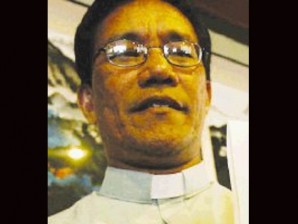Philippine Daily Inquirer
In this small Bulacan barrio, there will be no children costumed as devils, wicked witches or terrifying zombies and vampires to go trick-or-treating, carving jack-o’-lanterns or playing pranks on Halloween.
The eve of All Saints’ Day will instead find these children, aged 5 to 13, from Bagbaguin in Sta. Maria, Bulacan, dressed in pristine robes and radiant veils and garments to emulate some of the saints and martyrs venerated by the Catholic Church.
For instance, 11-year-old Ted Mercado, wearing a camisa de chino (Chinese collarless shirt), will entertain churchgoers with the inspiring story of the first Filipino saint, San Lorenzo Ruiz.
Eight-year-old Ira Domingio, in a gold-trimmed purple dress and holding a broom, ladle and key, will tell the story of the life of St. Martha, the sister of Lazarus and Mary of Bethany.
Costumed in a spotless white gown, aqua shawl and carrying a lamb figurine, Clarina Lengcuyan, 10, will get to narrate the life and death of St. Agnes, whose beheading was said to be the last and most vicious persecution of Christians by the Roman emperors.
The three will be among the 16 participants in the “March of Saints”—a presentation which is the highlight of the 6 p.m. Mass at the St. John the Evangelist Parish on Halloween—even as children their age in the more urbanized parts of the country enjoy a more Westernized form of observance.
Dressed like saints
“Instead of children wearing costumes copying Satan or impakto (monsters), why not dress up like saints so that they would be able to study and learn the lives of our saints?” said Fr. Nick Lalog II, the Bagbaguinparish priest.
According to Lalog, the Church has a “rich treasure” of saints who lived “beautiful lives” but because of the strong pull of the Western culture, their stories remain undiscovered—unfamiliar to many Filipinos, especially the younger ones.
Young Filipinos today would rather go to Halloween parties or go house-to-house in their scariest costumes collecting “treats” than read and learn about the lives of the saints, said Lalog.
The priest said he thought of introducing the “March of the Saints” to his parish this year to bring back the essence of Halloween, a Scottish variant of the fuller All-Hallows-Even (“evening”), that is, the night before All Hallows Day, or the mass-day of all saints.
Instituted by Pope Gregory III on Nov. 1, All Saints’ Day, also known as the “Feast of all Martyrs,” is a day of remembering and honoring the holy ones the Church has identified as worth emulating by those people still living on earth.
The “March of the Saints” is an idea that Lalog adopted from the St. Clement Parish of Toronto, Canada, which he visited in 2005.
The modest parish event is a “small contribution” to help reintroduce God into Filipino culture and into the lives of every Filipino, he said.
“It’s one way of making us aware again of the presence of God in our lives and our need to be holy and our need to be like the saints,” the priest said.
A form of teaching
During the “March of Saints,” the children, dressed in the image of the saints they represent, will join Lalog in the processional at the start of the Mass.
Each child will entertain parishioners with a brief story of the saint they represent during the homily.
“It is also a form of catechesis, in which the children get to teach other people, including their parents and neighbors, about the lives of saints,” Lalog said.
The other saints featured in the event are St. Paul the Apostle, St. Dominic, St. Bernadette Soubirous, St. John the Evangelist, St. Joseph, St. Rita de Cascia, St. Therese of the Child Jesus, and Blessed Jacinta, Francisco and Sister Lucia, the three children of the Fatima apparitions, among others.
During this year’s Halloween and All Saints’/All Souls’ Day observance, the Catholic Bishops’ Conference of the Philippines (CBCP) will also encourage Filipinos to celebrate the occasion by reflecting on the lives of saints and try emulating them.
“It’s okay to have parties and have a feast because we are celebrating the saints but we have to [be careful] not to fall down to that level of glorifying the evil one,” CBCP media director, Msgr. Pedro Quitorio, told reporters on Friday.
‘Symbols of Satan’
The Catholic Church frowns on such Westernized Halloween practices as people dressing up in gruesome images of ghosts, witches and demons, matching their outfits with glowing red horns and forks.
“Allowing children to use the symbols of Satan sends a bad subliminal message to them … with this, we are not glorifying the saints, actually this is a glorification of Satan himself,” said Quitorio.
The observance of Halloween is supposed to “enhance the feast of the saints” but over time, it has “morphed” into something that parade not the saints and their holy symbols but “icons of evil,” said the prelate.
“There’s nothing wrong with costume parties on Halloween as long as the costumes and symbols used are the ones that would enhance one’s faith and values,” Quitorio said.

No comments:
Post a Comment